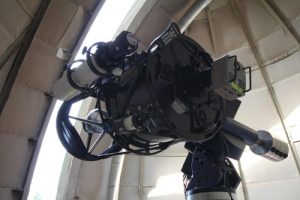50cm Telescope (EHT)
The 50 cm Planewave CDK Telescope located in the eastern dome is named Ernst-Hartwig-Telescope (EHT), after Ernst Hartwig, the first director of the Remeis Observatory. It was mounted on a 10Micron 4000 HPS mount in September 2013.
For the readers interested in the technical details:
- corrected Dall Kirkham type (CDK)
- spherical primary-, elliptical secondary mirror
- full compensation of aberrations
- focal length 3454 mm
- aperture ratio f/6.8
From the 1960s until the procurement of the EHT, no scientific observations could be performed directly at Remeis Observatory. With the new instrumentation, it is possible to revive a local scientific observation program. So far the EHT has been used for searching exoplanets with the timing method and as the main instrument for the MAPLE project.
Computing Resources
The observatory uses a typical client server system such that all data is stored on large disks and accessed via network file system (NFS). All machines (servers and clients) run Linux and are connected via gigabit ethernet. The observatory has about 40 workplaces plus about 20 special workplaces for the student lab and experiments.
For file serving and CPU intensive jobs the observatory has 7 servers and 12 computing workstations. The file servers have a total capacity exceeding 200 TB. All server disks are setup as RAID to avoid losing data in case of a hard disk failure. For computing not only 3 compute servers (with 144 computing nodes and more than 500 GB of RAM), but also 12 computing workstations (96 nodes and 96 GB of RAM) are available. In addition all more powerful desktop machines can be used to some extent. Computing jobs are automatically distributed in the cluster by a batch system.
Instruments
The Remeis Observatory hosts two stationary reflecting telescopes in its domes, the 50cm EHTand the 40cm CHT as well as a solar H alpha telescope with a DMK Video camera (see the corresponding pages for details). For both telescopes additional instruments like cameras and spectrographs are available:
- BIG STX 16803 CCD camera (only @ EHT)
- SBIG STL 11000M
- SBIG St-i Guider
- Planetary camera
- Canon EOS 1000dA
- BACHES spectrograph
- several eyepieces
At the moment, both telescopes are mainly used for educational purposes, i.e., during the lab course. An exception is the MAPLE project, a small scientific observing campaign conducted with the EHT.
We also operate a small weather station for the local sky conditions together with an all sky camera here!
History
Die deutsche Textfassung gibt es hier.
The Dr. Karl Remeis Observatory was founded in 1889 and is a home to astronomers from countries all over the globe ever since.
The founding father was Dr. Karl Remeis and you can find some information about him and his life here. The first director of the observatory was Dr. Ernst Hartwig, who discovered the first Supernova in another galaxy and travelled to the Southern Hemisphere to observe the Venus transit in 1882. Read more about him here.
If you are interested in our historical buildings, you can read about them here or even come to one of our public guided tours.
About us
Dr. Karl Remeis-Observatory is the Astronomical Institute of the University of Erlangen – Nuremberg. It is located in the city of Bamberg. The observatory was founded in 1889 as a private institution. In 1962, it became part of the University of Erlangen – Nuremberg as its Astronomical Institute. The observatory is one of only three astronomical institutes in the state of Bavaria. Next to the observatory in Hamburg, Dr. Karl Remeis-Observatory is the only modern astronomical institute in Germany that is still located in its original 19th century buildings.
Since 2007 Remeis observatory has been part of the Erlangen Center for Astroparticle Physics (ECAP), in which the university has merged the research in the fields of neutrino physics, X-ray astronomy and space- and ground based gamma-ray astronomy. As members of the physics department, scientists at the observatory are not only involved in research on different topics in astrophysics but also responsible for teaching of astronomy and astrophysics in Erlangen.
For their research, the scientists at the observatory make use of the optical telescopes of ESO (Chile) and observatories on the Canary Islands, in Spain, and Hawaii, radio telescopes and arrays, e.g., in Germany (Effelsberg), the USA (VLA), Chile (ALMA), as well as satellites such as the Hubble Space Telescope, XMM-Newton, INTEGRAL, Chandra, and eROSITA. Scientists at the observatory also contribute to the development of new instruments such as NewATHENA, AXIS, or THESEUS. For data analysis, modelling, and simulations, local computing facilities as well as the computing clusters in Erlangen and Munich as well as of many institutes in the US are used.
Today, the institute staff consists of more than 50 people, including three professors, three assistants, some Post-Docs, and many PhD, master, and bachelor students, and administrative staff. The research is funded, amongst other, by Deutsche Forschungsgemeinschaft, Deutsches Zentrum für Luft- und Raumfahrt, the European Union, European Space Agency, and the Humboldt foundation.
Music: Royalty Free Music from Bensound
Follow us on Instagram and LinkedIn:
Contact/Directions
The observatory is at Latitude 49d53m09.6s North and Longitude 010d53m23.2s East (DHDN).
Arrival by car
- Coming from South (Erlangen/Nuremberg, A73)
Exit at “Bamberg Süd”
At second traffic light, turn left ( Forchheimer Strasse, -> Klinikum)
At second traffic light, turn left (Münchner Ring, -> Klinikum, Würzburg B22)
Continue with 3. - Coming from North (A70)
Exit A70 at “Bamberg Zentrum”
Follow Berliner Ring southbound ~4km
At y-intersection, continue right (Münchner Ring, -> Klinkum, Würzburg B22)
Continue with 3. - From Münchner Ring
Follow Münchner Ring crossing the river and beyond the next traffic light
After ~800m there is a pedestrian bridge crossing the street. Below that bridge, take the unsigned exit on the right (Schellenberger Strasse)
Follow Schellenberger Strasse until the end, then turn right into Oberer Stephansberg
Follow the street downhill, turn right at the first possibility (Sternwartstrasse)
Follow Sternwartstrasse uphill towards the observatory - Parking is available behind the observatory, either use the gate on the left of the observatory’s main building, or use the left hand gate at the end of Sternwartstrasse, drive uphill until the pavement changes to gravel and park. Do not park on the side of the yellow “Bundschuh-Haus”! Alternatively you can park on the Sternwartstrasse, but note that parking is time limited and only possible on the right hand side of the road (facing upwards).
Arrival by train/bus (Bamberg Central Station)
- Walking from the station to the observatory takes you ~30 min. Ask for “Spezikeller”, which is right next to the observatory and much better known.
- You can shorten your walk taking the bus:
Cross the street in front of the station building and turn right to the bus stop
Take any bus to the central bus station (ZOB). If you are lucky, you can go on directly from there, but probably you have to change. Attention: Buses change their line number at the ZOB!
Take one of the lines 901, 908, 912, 937 to “Schulplatz”. From here you have to walk (~8 min)
Cross the street “Unterer Kaulberg” and the small parking lot and enter the small street “Hölle” (which is blocked for cars).
Keep walking straight (Untere Seelgasse) until you’ve walked uphill to a T-crossing
Turn right into Oberer Stephansberg.
After about 15m, at the pedestrian crossing at the brewery turn left into the Sternwartstrasse and follow the road uphill to the observatory - If you have luggage or don’t want to walk, a taxi rig is in front of the main train station building. The trip to
the observatory will cost approximately 15 EUR.
Arrival by plane
- If at all possible, fly to Nuremberg Airport (NUE), this is 3 hours closer than flying to
Frankfurt or Munich (prefer FRA to MUC if NUE is not an option). - Arriving at NUE, pick up your luggage (waiting time is typically less than 10 minutes). Then take the subway to Nuremberg train station (entrance is directly in front of the terminal, subways leave every 20 minutes, get a ticket for zone 10, about 15 EUR). Then take the S-Bahn or the regional train to Bamberg (runs every 30 minutes; do NOT take the ICE, this requires a separate ticket and the time gain is minuscule). Then follow the instructions above (the ticket will be valid on the bus).
The whole trip will take 1-1.5 hours from landing and cost about 15 EUR. Alternatively, take the taxi 45 Minutes, 80-110 EUR. - Arriving at FRA, take the ICE train from the Frankfurt Flughafen Fernbahnhof to Würzburg (trains run every hour) and switch to the regional train to Bamberg (trains run every 30 minutes). Then follow the instructions above.
Depending on the time of arrival in FRA and whether you have luggage or not, expect the whole trip to take about 4 hours from landing (the train trip itself will take about 3h, including walk times at FRA (add 30-45 minutes if arriving at Terminal 2), and to cost 60 EUR. There are no connections from FRA to Bamberg after 20:00. - Arriving at MUC, take the subway from the airport subway station to Munich main train station and then switch to one of the ICE trains towards Bamberg. Depending on the time of day, you might be able to get an ICE directly to Bamberg, otherwise you will have to switch trains to the regional train or S-bahn in Nuremberg.
The whole trip will take a minimum of 4 hours including walking times. There is only one connection that departs MUC after 20:00, the cost will be around 70 EUR.
Dr. Karl Remeis Sternwarte
Die Dr. Karl Remeis-Sternwarte ist das Astronomische Institut der Universität Erlangen-Nürnberg. Sie befindet sich in der Stadt Bamberg. Die Dr. Remeis-Sternwarte wurde 1889 als private Institution gegründet. 1962 wurde sie als Astronomisches Institut in die Universität Erlangen-Nürnberg integriert. Für mehr Informationen über die Geschichte der Sternwarte besuchen Sie bitte die Seiten des Fördervereins.
Die Wissenschaftlerinnen und Wissenschaftler der Sternwarte forschen an verschiedenen astrophysikalischen Themen und sind für die Lehre der Astronomie und Astrophysik an der Universität Erlangen verantwortlich.
Astronomie und Astrophysik sind ein untrennbarer Bestandteil der modernen Physik, sodass das Studium nur im Rahmen eines Physikstudiums möglich ist. Weitere Details finden Sie unter Forschung und Lehre / Studieninformationen.






